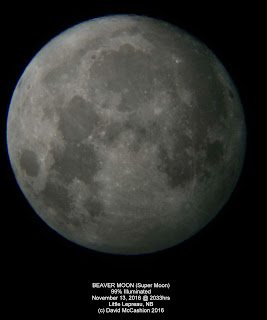Date Time: November 13, 2016 1700-2200 hrs
Weather: Windy at first, died down to no wind after 2000 hrs. Cool, 7C and clear. Surprisingly a few bugs were flying around.
Attendance: Myself.
Equipment: Canadian Telescopes 80 ED/APO on a Vixen Alt/Az mount with a 12 mm eyepiece. Canon Rebel Xsi with 18-55mm and 75-300mm lenses on tripod. Samsung Nexus 4 attached to telescope with an Ioptron cellphone adapter with a 15mm built in eyepiece.
Objective: To view and image the Full Beaver Moon which was suppose to become completely full early morning of November 14, 2016.
Highlights:
- According to many reports, this cycles Full Moon, which occurs at 0952 hrs AST November 14, 2016 will appear as a full Moon to local observers the day before and a day after this time. For more details and dispel myth's about the so called super moon check out his website at Space.com. Look for higher tides than normal for the next few days.
- Was surprised to see the Moon, just above the trees in the east at 1711 hrs. Still lots of light out and it appeared red, low on the horizon. It didn't appear to be any different than other full moons till later on in the evening. By 2300 hrs it was 100% Illuminated and was noticeably brighter than normal. Looked to be the same size as normal though, to the unaided eye.
- At the same time the moon was rising above the horizon at 1710 hrs, a very bright Venus was very high up in the Southwest. It was to the right of Sagittarius which was partly dipping below the horizon. Through the telescope Venus appeared in a fat gibbous phase. Many colors could be seen surrounding it.
- Later on, around 2030 hrs, Mars could be seen in the SW in Capricornus.
- Searched the NE sky for Perseus and the variable star Algol. Imaged it and then checked for its minimum. According to Sky and Telescope magazine the Algol minimum will be at 1457 AST November 14, 2016. Will attempt to image this star at its maximum to show the difference through images. Its maximum occurs 2 days and 20 hours after maximum.
- At 2047 hrs imaged the Summer Triangle as it lowered in the NW. A sure sign that winter is on its way. When the moon cycle moves closer to the new phase and view gets better, this is a great area to search for deep sky objects and double stars. Now that this area of the sky has moved down from its zenith position, it will be easier to view through a telescope and image.
- Did a quick look out, through the window at approx 2330 hrs and the Moon was shining like I've never seen before. Put deep shadows on the ground, shining a brilliant bluish white but still looked the same size as all the other full moons.
- No Shooting stars or satellites were seen. Been quite a while since I've seen a shooting star.
Images:






No comments:
Post a Comment